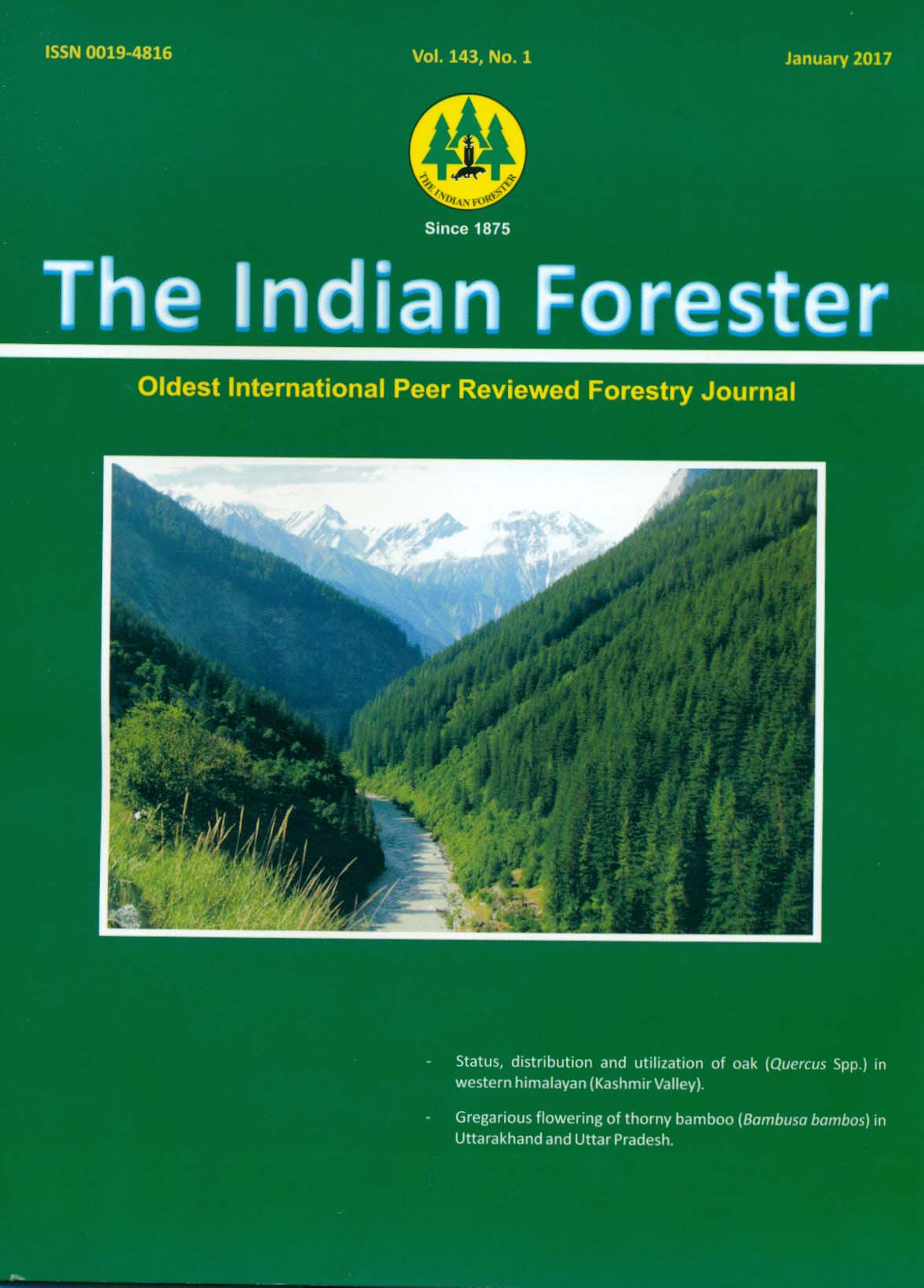Performance Evaluation of Boric and Silicic Acid Treatment in Plywood by Shear Strength
DOI:
https://doi.org/10.36808/if/2017/v143i1/113508Keywords:
Compatibility, Glue Shear Strength, Phenolic Adhesive, Poplar.Abstract
Plywood plays a major role in consumption of wood panels in India due to its wide applicability in structural as well as nonstructural purposes. Their extensive uses in outdoor purposes create the favourable conditions for fungal attack, thus required external protection by wood preservatives. The major issue come through treatment of plywood is compatibility of preservative with the adhesive used. In the present study, plywood was treated with boric acid and silicic acid separately and in different combinations by veneer treatment method. Three concentrations i.e. 2%, 3% and 4% of each chemical and their combinations were used to treat plywood. The compatibility of these chemicals was evaluated in plywood by testing glue shear strength (GSS) in dry as well as in wet state. The study revealed that boric acid poorly affected the GSS of plywood in both test states, whereas silicic acid treated plywood performed best. Plywood treated with combinations of boric and silicic acid had shown improved shear strength and passed the minimum criteria of Boiling Water Resistant grade plywood.References
Anon. (1974). Specification for synthetic resin/Adhesives for plywood (Phenolic and Aminoplastic). IS: 848 Bureau of Indian standards. 9, Bahadur Shah Zafar Marg, New Delhi, India
Anon. (1983). Specification for the methods of test for plywood. IS: 1734. Bureau of Indian standards. 9, Bahadur Shah Zafar Marg, New Delhi, India.
Anon. (1989). Plywood for general purposes-specification. IS: 303. Bureau of Indian standards. 9, Bahadur Shah Zafar Marg, New Delhi, India
Anon. (1999). Preservative treated plywood. APA- The engineered wood association. www.apawood.org. [Cited 18 Jan 2014]
Ayrilmis N. and Winandy J.E. (2007): Effects of various fire-retardants on plate shear and five-point flexural shear properties of plywood. Forest Products Journal, 57(4): 44-49
Barnes H.M. and Amburgey T.L. (1993). Technologies for the protection of wood composites. In: Proceedings of IUFRO Symposium on the Protection of Wood Based Composites Products.May 1993, Orlando, Florida, USA: 7-11
Dimri M.P. and Shukla K.S. (1991). Study on the effect wood preservatives on glue bond strength of plywood. Van Vigyan, 29(1): 35-39
Dimri M.P., Shukla K.S. and Kumar S. (1992). Further study on the effect wood preservatives on glue bond strength of plywood. Journal of Timber Development Association, 38(2): 14-18
Frihart C.R. (2004). The challenge of bonding treated wood. Proceedings of ICECFOP1 - International Conference on EnvironmentallyCompatible Forest Products Oporto, Portugal, 22-24 September
Frihart C. and Linda F.L. (2006). Adhesive bonding of wood treated with ACQ and copper azole preservatives. Forest Products Journal, 56(9):9093
Go H. (1988). New development in wafer board/OSB resin technology. Particleboard/Composite material symposium, Washington state university pillman: 123-132
Kros A.W. (2005). Aqueous solution of non-colloidal silicic acid and boric acid. European patent EP1517874 A1
Laks P.E., Haataja B.A., Palardy R.D. and Bianchini R.J. (1988). Evaluation of adhesives for bonding borate treated flake boards. Forest Products Journal, 38(11/12): 23–24
Lee S., Wu Q. and Strickland B. (2001). The influence of flake chemical properties and zinc borate on the gel time of phenol resin for oriented strand board. Wood and Fiber Science, 33:425-436
Mandal K. (2004). Make unorganized players pay taxes. Corporate news published in Business line, 14 June
Mai C. and Militz H. (2004) Modification of wood with silicon compounds. Treatment systems based onorganic silicon compounds - a review. Wood Science Technology, 37:453-461.
Pizzi A. and Mittal K.L. (2003). Handbook of adhesive technology, second edition by Marcel Dekker AG, Switzerland, Taylor & Francis Group, LLC
Reinprecht L. (2007). Selected laboratory tests of boron efficacy against wood-destroying fungi and moulds. COST Action E37: 8th Workshop BRASOV, Romania, 18.-19
Reinprecht, L. and Perlác, J. (1995): Properties of particleboards protected by TBTN and TCMTB fungicides. In: Wood Modification '95, 10th Symposium, Poznan - Poland, pp. 255-264
Shukla K.S. (1991). Studies on the preservation of plywood.treatment of veneers with water borne preservatives by non pressure techniques, J. Timber Development Association (India), 37(3):34-47
Tomak E.D., Yýldýz Ü.C., Yýldýz S. and Pesman E. (2008). The effect of treatments in boron steaming medium on boron leaching and strength th properties of wood. 39 IRG Annual Meeting Istanbul, Turkey. 25-29 May
Vick C.B., DeGroot R.C. and Youngquist J. (1990). Compatibility of non acidic waterborne preservatives with phenol-formaldehyde adhesive. Forest Products Journal, 40(2):16-22
Willis J.H. (1954). Soluble silicates and synthetic insoluble silicates. Encyclopaedia of chemical technology, vol 12. The interscince, inc, new York, NY 955 pp
Yalincilic M., Gezer E.D., Tkahashi M., Demiric Z., Ilhan R. and Imamura Y. (1999). Boron addition to non or low-formaldehyde cross-linking reagents to enhance biological resistance and dimensional stability of wood. Holz als Roh- und Werkstoff, 57, 351-357
Yamaguchi H. (2002). Low molecular weight silicic acid- inorganic compound complex as wood preservative. Wood Science and Technology, 36(5): 399-417
Yamaguchi H. (2003). Silicic acid: Boric acid complexes as wood preservatives. Wood Science and Technology, 37: 287-291
Yamaguchi H. (2005). Silicic acid/ boric acid complexes as ecologically friendly wood preservatives. Forest Products Journal, 55(1): 88-92
Downloads
Downloads
Published
How to Cite
Issue
Section
License
Unless otherwise stated, copyright or similar rights in all materials presented on the site, including graphical images, are owned by Indian Forester.





